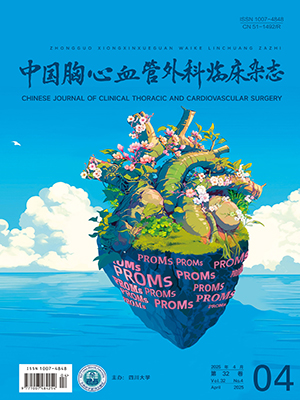The treatment of acute Stanford type A aortic dissection has always been extremely challenging. Organ malperfusion syndrome is a common severe complication of acute aortic dissection, which can cause organ ischemia and internal environment disorder. Malperfusion increases early mortality, and impacts the long-term prognosis. In recent years, many scholars have done some studies on aortic dissection complicated with malperfusion. They explored the pathogenesis, proposed new classification, and innovated new treatment strategies. However, at present, the treatment strategies of acute Stanford type A aortic dissection complicated with organ malperfusion are different at different centers and consensus on its treatment is still lacking. Therefore, this review summarized the pathogenesis, classification, treatment strategy, and prognosis of acute Stanford type A aortic dissection complicated with malperfusion.
Citation:
ZHANG Bowen, DUN Yaojun, LIU Yanxiang, GAO Haoyu, REN Jie, WANG Luchen, ZHOU Sangyu, XIE Mingxin, SUN Xiaogang. Advances in acute Stanford type A aortic dissection with organ malperfusion. Chinese Journal of Clinical Thoracic and Cardiovascular Surgery, 2024, 31(8): 1235-1241. doi: 10.7507/1007-4848.202211049
Copy
Copyright © the editorial department of Chinese Journal of Clinical Thoracic and Cardiovascular Surgery of West China Medical Publisher. All rights reserved
| 1. |
|
| 2. |
|
| 3. |
|
| 4. |
|
| 5. |
|
| 6. |
|
| 7. |
|
| 8. |
|
| 9. |
|
| 10. |
|
| 11. |
|
| 12. |
|
| 13. |
Ehrlich MP, Ergin MA, McCullough JN, et al. Results of immediate surgical treatment of all acute type A dissections. Circulation, 2000, 102(19 Suppl 3): Ⅲ248-Ⅲ252.
|
| 14. |
|
| 15. |
|
| 16. |
|
| 17. |
|
| 18. |
|
| 19. |
|
| 20. |
|
| 21. |
|
| 22. |
|
| 23. |
|
| 24. |
|
| 25. |
|
| 26. |
|
| 27. |
Tsukube T, Hayashi T, Kawahira T, et al. Neurological outcomes after immediate aortic repair for acute type A aortic dissection complicated by coma. Circulation, 2011, 124(11 Suppl): S163-S167.
|
| 28. |
Di Eusanio M, Patel HJ, Nienaber CA, et al. Patients with type A acute aortic dissection presenting with major brain injury: Should we operate on them? J Thorac Cardiovasc Surg, 2013, 145(3 Suppl): S213-S221.
|
| 29. |
|
| 30. |
|
| 31. |
|
| 32. |
|
| 33. |
|
| 34. |
|
| 35. |
|
| 36. |
|
| 37. |
|
| 38. |
|
| 39. |
|
| 40. |
Norton EL, Wu X, Farhat L, et al. Dissection of arch branches alone: An indication for aggressive arch management in type A dissection? Ann Thorac Surg, 2020, 109(2): 487-494.
|
| 41. |
Norton EL, Wu X, Kim KM, et al. Is hemiarch replacement adequate in acute type A aortic dissection repair in patients with arch branch vessel dissection without cerebral malperfusion? J Thorac Cardiovasc Surg, 2021, 161(3): 873-884.
|
| 42. |
|
| 43. |
|
| 44. |
Kreibich M, Desai ND, Bavaria JE, et al. Common carotid artery true lumen flow impairment in patients with type A aortic dissection. Eur J Cardiothorac Surg, 2020, ezaa322.
|
| 45. |
|
| 46. |
|
| 47. |
|
| 48. |
|
| 49. |
|
| 50. |
|
| 51. |
|
| 52. |
|
| 53. |
|
| 54. |
|
| 55. |
|
| 56. |
|
| 57. |
|
| 58. |
|
| 59. |
|
| 60. |
|
| 61. |
|
| 62. |
|
| 63. |
|
| 64. |
|
| 65. |
|
- 1.
- 2.
- 3.
- 4.
- 5.
- 6.
- 7.
- 8.
- 9.
- 10.
- 11.
- 12.
- 13. Ehrlich MP, Ergin MA, McCullough JN, et al. Results of immediate surgical treatment of all acute type A dissections. Circulation, 2000, 102(19 Suppl 3): Ⅲ248-Ⅲ252.
- 14.
- 15.
- 16.
- 17.
- 18.
- 19.
- 20.
- 21.
- 22.
- 23.
- 24.
- 25.
- 26.
- 27. Tsukube T, Hayashi T, Kawahira T, et al. Neurological outcomes after immediate aortic repair for acute type A aortic dissection complicated by coma. Circulation, 2011, 124(11 Suppl): S163-S167.
- 28. Di Eusanio M, Patel HJ, Nienaber CA, et al. Patients with type A acute aortic dissection presenting with major brain injury: Should we operate on them? J Thorac Cardiovasc Surg, 2013, 145(3 Suppl): S213-S221.
- 29.
- 30.
- 31.
- 32.
- 33.
- 34.
- 35.
- 36.
- 37.
- 38.
- 39.
- 40. Norton EL, Wu X, Farhat L, et al. Dissection of arch branches alone: An indication for aggressive arch management in type A dissection? Ann Thorac Surg, 2020, 109(2): 487-494.
- 41. Norton EL, Wu X, Kim KM, et al. Is hemiarch replacement adequate in acute type A aortic dissection repair in patients with arch branch vessel dissection without cerebral malperfusion? J Thorac Cardiovasc Surg, 2021, 161(3): 873-884.
- 42.
- 43.
- 44. Kreibich M, Desai ND, Bavaria JE, et al. Common carotid artery true lumen flow impairment in patients with type A aortic dissection. Eur J Cardiothorac Surg, 2020, ezaa322.
- 45.
- 46.
- 47.
- 48.
- 49.
- 50.
- 51.
- 52.
- 53.
- 54.
- 55.
- 56.
- 57.
- 58.
- 59.
- 60.
- 61.
- 62.
- 63.
- 64.
- 65.




